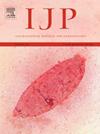亚洲dirofilia sp. 11 .(螺旋藻目:盘尾丝虫科)-用形态-分子结合的方法定义。
IF 3.2
2区 医学
Q1 PARASITOLOGY
引用次数: 0
摘要
盘尾虫科(丝状总科)的寄生线虫与脊椎动物宿主一起进化了数百万年。虽然形态学方法在物种鉴定中发挥了核心作用,但许多分类群仍然是神秘的,难以区分,使诊断和对其流行病学的理解复杂化。在临床上相关的属中有盘尾丝虫属和钩丝虫属,后者导致犬心丝虫病和人类罕见的人畜共患感染等疾病。尽管我们对犬心丝虫(犬心丝虫)的了解有所进展,但在其他犬心丝虫种类和基因型及其对动物和人类健康的影响方面仍存在重大差距。在这项研究中,我们对来自斯里兰卡狼犬的一种新的Dirofilaria asiatica sp. nov.进行了已知的第一次全面的形态和分子表征。这一新物种与先前在香港人类中发现的一种新的Dirofilaria基因型在遗传学上一致,并使用形态和分子相结合的方法进行了描述。研究结果表明,11月的亚洲丝虫与其他已知物种(包括repens和immitis)明显不同,可能是南亚和东南亚大多数人畜共患的Dirofilaria感染的原因。此外,犬类和人类宿主中隐孢子虫的鉴定强调了分子工具对特异性鉴定的重要性,特别是在形态学信息不足的情况下。本研究对亚洲盘尾丝虫病的分类学、人畜共患潜力及其与盘尾丝虫病近缘种的关系进行了初步探讨。这种形态和分子相结合的方法为未来丝状线虫的研究建立了一个框架,对提高兽医和医学背景下对丝状线虫流行病学的诊断和理解具有重要意义。本文章由计算机程序翻译,如有差异,请以英文原文为准。

Dirofilaria asiatica sp. nov. (Spirurida: Onchocercidae) – Defined using a combined morphological-molecular approach
Parasitic nematodes of the family Onchocercidae (superfamily Filarioidea) have evolved alongside vertebrate hosts for millions of years. While morphological methods have played a central role in identifying species, many taxa remain cryptic and are challenging to differentiate, complicating diagnosis and the understanding of their epidemiology. Among the clinically relevant genera are Onchocerca and Dirofilaria, the latter being responsible for illnesses such as heartworm disease in canines and rare zoonotic infections in humans. Despite advances in our knowledge of the canine heartworm (Dirofilaria immitis), substantial gaps remain regarding other Dirofilaria spp. and genotypes, and their impact on both animal and human health. In this study, we conducted the first known comprehensive morphological and molecular characterisation of a novel Dirofilaria sp., Dirofilaria asiatica sp. nov., from Canis lupus familiaris in Sri Lanka. This new species, genetically consistent with a previously identified novel genotype of Dirofilaria, initially found in humans in Hong Kong, was described using a combined morphological and molecular approach. The findings reveal that D. asiatica sp. nov. differs significantly from other known species, including D. repens and D. immitis, and might be responsible for the majority of zoonotic Dirofilaria infections in southern and southeastern Asia. Furthermore, the identification of cryptic Dirofilaria spp. in both canine and human hosts emphasises the importance of molecular tools for specific identification, particularly when morphological information is inadequate. This study provides insights into the taxonomy and zoonotic potential of D. asiatica sp. nov., as well as its relationship with related species of onchocercids. This combined morphological and molecular approach establishes a framework for future investigations of filarioid nematodes, with implications for improving diagnosis and understanding of their epidemiology in both veterinary and medical contexts.
求助全文
通过发布文献求助,成功后即可免费获取论文全文。
去求助
来源期刊
CiteScore
8.40
自引率
2.50%
发文量
76
审稿时长
23 days
期刊介绍:
International Journal for Parasitology offers authors the option to sponsor nonsubscriber access to their articles on Elsevier electronic publishing platforms. For more information please view our Sponsored Articles page. The International Journal for Parasitology publishes the results of original research in all aspects of basic and applied parasitology, including all the fields covered by its Specialist Editors, and ranging from parasites and host-parasite relationships of intrinsic biological interest to those of social and economic importance in human and veterinary medicine and agriculture.

 求助内容:
求助内容: 应助结果提醒方式:
应助结果提醒方式:


